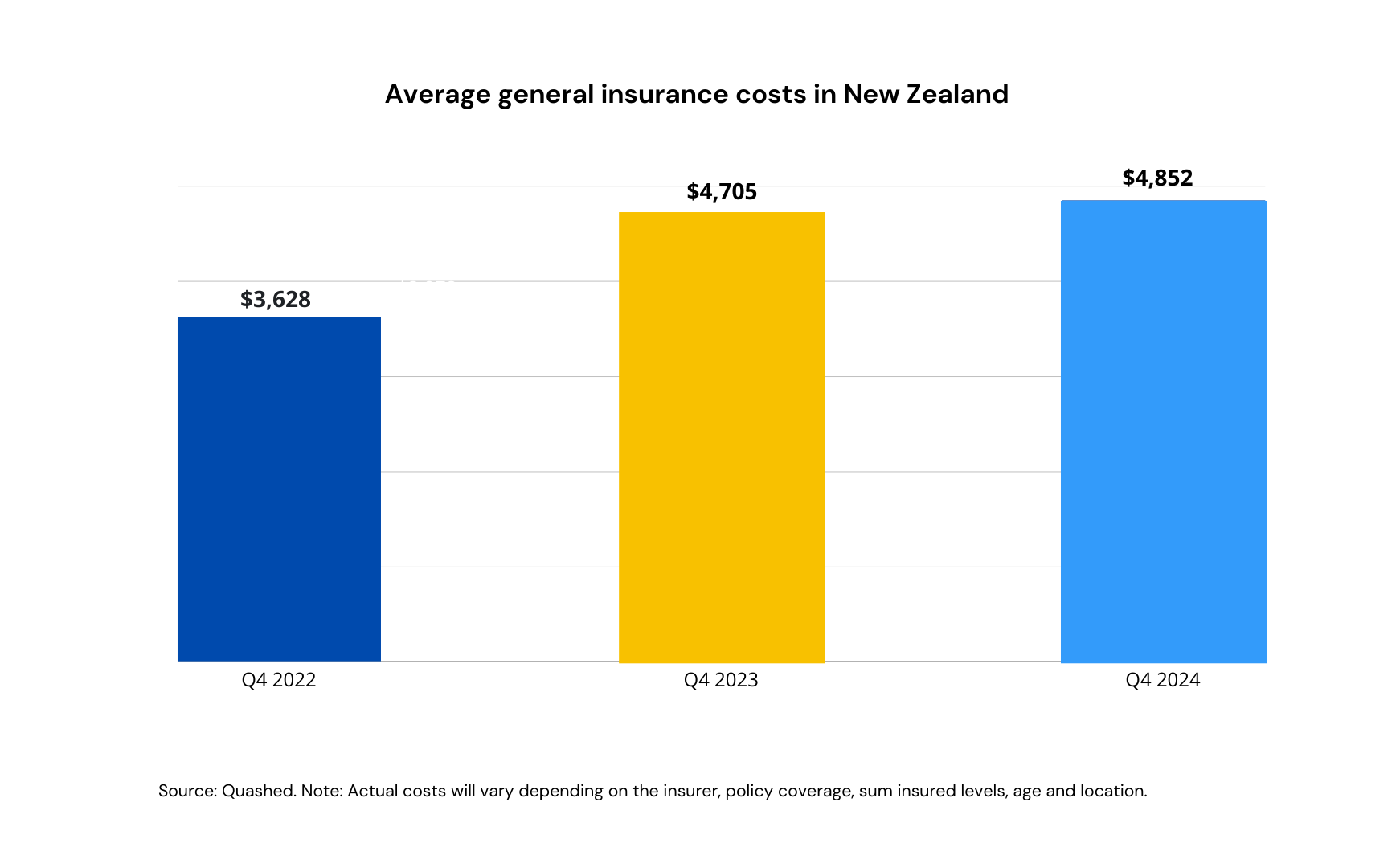
Insurance is often pushed to the bottom of our to-do list. However, this could be costing us a lot of money.
Comparing and shopping your insurance (such as car insurance, home insurance, contents insurance, and even life insurance) in New Zealand doesn’t have to be overwhelming nor does it have to take hours.
In this article, we explore why consumers should shop and compare their insurance, how much insurance costs in New Zealand, and what an average consumer can save by shopping their insurance. Lastly, we look at how Quashed can help.
Whether you’re looking to reduce your insurance premium costs or check if your cover still stacks up, read on.
Why You Should Compare Your Insurance in New Zealand
Insurance is one of those purchases that we continuous make over our lifetime, yet spend little time really shopping it and it ends up costing the average consumer more than $100,000 over our lifetime.
The average household could expect to spend roughly $6,000 on just general insurance a year. This excludes health, life, pet, travel and other insurance. Here's a high level breakdown:
Car insurance = $2,600 (assuming 2 cars x $1,300 per comprehensive policy)
House insurance = $2,600
Contents insurance = $800
Over just 15 years, this will amount will balloon to $100,000 (accounting for very conservative increase). Imagine, if you could save 20% on your insurance in this time. This will put more than $20,000 back in your pocket.

So, besides being able to save heaps on your insurance, there are a few other good reasons to compare and shop your insurance policies:
Stop paying more than you have to (i.e. the good ol' loyalty tax)
Find policy with benefits that better suits you
Feel confident you've got the right protection sorted
We all know insurance is personal—what works for your mate down the road might not work for you. It really comes down to your own situation, budget, and what you need cover for. That’s why it’s important to compare insurance in New Zealand and find a policy that fits your needs. So, what are Kiwis actually paying for insurance? Let’s take a look at the numbers to understand how insurance costs are tracking and what you might expect.
How much are Kiwis paying for insurance in 2025

We know insurance can feel like a mystery, so we've crunched the numbers in our latest Quashed Index (Q4 2024 data) to give you a clearer picture of how much insurance costs in New Zealand.
Insurance Type | Average Annual Premium ($) | Annual Premium Increase % |
House Insurance | $2,704 | 2.1% |
Car Insurance | $1,325 | 6.7% |
Contents Insurance | $823 | 0.9% |
Source: Quashed, data as at Q4 2024. Actual costs will vary depending on the insurer, policy coverage, excess levels, and individual risk factors such as age, location, and driving history.
Insurance costs in New Zealand have been climbing in recent years, and it’s not just your imagination. From Q4 2022 to Q4 2024, the average cost of general insurance has seen some significant jumps, as you'll see in the graph below.

Back in Q4 2022, the average cost was $3,628. By Q4 2023, that had shot up by 30% to $4,705. The latest data from Q4 2024 shows the average cost at $4,852—an increase of another 3.1%.
Digging a little deeper, our Quashed Insurance Index shows specific types of insurance following a similar trend.
House insurance in NZ now averages $2,704, which represents a 2.1% increase from last year. Car insurance premiums are sitting at $1,325, up 6.7%, and contents insurance is up 0.9%, now averaging $823 per year.
These rising costs are a reality check for Kiwis as they try to stay on top of their insurance game.

What affects your insurance costs in NZ
Insurance premiums in New Zealand are influenced by several factors. Understanding these can help you make informed decisions and potentially reduce your costs.
Location: Homes in areas prone to natural disasters or higher crime rates generally have higher premiums.
Policy coverage: Comprehensive policies cost more but provide broader protection compared to basic or third-party-only options.
Sum insured value: Higher-value homes, cars and contents typically cost more to insure due to their higher replacement costs.
Age and driving history: Younger drivers and those with previous claims often face higher car insurance premiums.
Excess amount: Choosing a higher excess can lower your monthly premiums, but it also means paying more out-of-pocket if you need to make a claim.
Claims history: Claims in recent times can result in insurers charging higher premiums to offset the risk you present.
Inflation and rebuild costs: Rising construction costs, inflation, and supply chain disruptions continue to push up home insurance premiums.
Insurance company: Each insurer price their policies differently. It comes down to how effective they can manage their risks and how efficient they are at running their business. Also, how much they make in margins will also impact your cost.
How to reduce your insurance costs
If your insurance is getting expensive and unaffordable, there are ways to reduce your insurance premiums:
Review your coverage: Ensure you are not over-insured or paying for extras you do not need.
Increase your excess: A higher excess can lower your premiums, but only if you can afford the out-of-pocket cost in the event of a claim.
Compare providers regularly: Insurers adjust their pricing frequently, so using a tool like Quashed helps you keep track of insurance options available to you in the market.
Comparing insurance options gives you a clear view of where you might be overpaying. Get tailored quotes with Quashed.co.nz and find a policy that suits your needs in minutes.

How to compare your insurance in NZ
Similar to shopping for most things, you'd want to know what your options are. Surprisingly, most Kiwis are not aware that there actually are a few options in New Zealand. The big known brands such as AA, AMI, State and Tower needs no introduction. However, there are options such as purchasing insurance from banks (ANZ, ASB, BNZ, Westpact, Kiwibank, and more) and also other insurers such as AMP, Assurant, Cove, Provident, Star Insure, Initio and more.
Once you know your options, it comes down to a couple of factors such as:
How much are these options; and
Which option is better (policy benefits, claim limits, service, etc.)
So how do you compare insurance?
In the past, comparing your insurance can be a time consuming and frustrating experience. You will have to ring up, or visit each insurance company's website, and provide your details to get a quote. This will have to be repeated several times before you get an understanding of the different options available to you.
Even then, you'll mostly only be comparing the price and would struggle to compare the policy benefits and understand how each insurance policy is different. For example, one insurance company may provide you with excess-free windscreen repair but the other may charge you $80 a year for this benefit. Another insurer may cover you for loss or stolen car keys, but another insurer may not. This can end up costing you hundreds when it comes to claim.
Today with Quashed.co.nz, it's quick and easy to compare insurance. You enter your details once, and you are presented with a number of options with a clear comparison of insurance premiums and also policy benefits. This saves you time and confusion so you can easily get an understanding of how different insurance options compare.
What's Quashed and how can it help compare insurance

We get it—comparing insurance the old-school way means spending hours scrolling through insurer websites, trying to make sense of confusing policies and fine print. With Quashed, you can largely skip the hassle and let us do the hard work for you.
Our smart, AI-powered platform allows you to store all your existing insurance policies, compares it against the market, and highlights some of the available options—all in one place. This is our super feature called Market Scan. No more sifting through endless tabs or working out insurance jargon. We provide clear, side-by-side comparisons that show you what matters most, making it easy to spot the right policy without the headache and frustration that typically comes with this.
And because we’re insurer-neutral, you can trust that we are all about you. More than 60,000 Kiwi consumers have already saved time and money with Quashed, and you can too today.
Ready to compare insurance, experience Quashed for yourself today
Take the guesswork out of comparing insurance with Quashed. It’s fast, free, and designed for Kiwi consumers who want insurance options—without the hassle.
Compare now and discover insurance that works for you.
Further reading
Here are some great reads we've selected for you:
How to Save Money on Insurance: Clever ways to cut your insurance costs
Insurance Mistakes to Avoid: Costly blunders that could drain your wallet with insurance
Comparing Insurance Costs for Cars: Insurance cost differences across the most popular vehicles in NZ
Compare House Insurance Quotes: Smart ways to evaluate house insurance cover
Cheapest vs Best Car Insurance: Striking the balance between price and protection with your car insurance
Car Insurance Quotes Guide: Insider tips to compare and save on insurance
Key considerations with Contents Insurance: Snagging affordable cover without cutting corners
Average Insurance Costs in NZ: A deep dive into what Kiwis really pay for car, house and contents insurance
Home Insurance Guide: A must-read for protecting your biggest asset
Complete Contents Insurance Guide: Everything you need to know—minus the jargon
Renewing Car Insurance Tips: A no-fuss guide to your next policy refresh
Moneyhub vs Quashed: Learn more about how they compare when it comes to insurance
Tesla and Insurance: The costs of insuring a Tesla car in New Zealand
Insurance FAQs
Why is my house insurance premiums getting more expensive in NZ?
House insurance premiums are rising due to inflation, increasing rebuild costs, and more frequent extreme weather events. Even if you haven’t made a claim, insurers are adjusting premiums based on broader industry risks.
Some reasons for rising costs:
Building costs have increased – New Zealand construction costs have risen considerably.
More frequent and severe weather events – New Zealand experienced its wettest year on record in 2023, leading to a surge in claims
Rising reinsurance costs – Global insurance companies that back local insurers have raised their prices due to climate-related disasters. These costs are passed down to customers.
Risk reassessments by location – Some regions, previously considered lower-risk, have been reclassified due to flood mapping and climate concerns.
How can I lower my house insurance costs?
There are several ways to reduce your premiums without compromising on essential cover.
Increase your excess – A higher excess means lower premiums, but also higher out-of-pocket costs when making a claim.
Review your sum insured – Ensure your coverage reflects the true rebuild cost without over-insuring or under-insuring.
Pay your premiums annually instead of monthly – Most insurers charge extra for monthly payments.
Compare quotes with Quashed.co.nz – Shopping your insurance ensures you’re not overpaying. Prices can vary significantly between providers.
Insurance coverage basics
What exactly does house insurance cover in NZ?
House insurance covers damage to your home caused by events such as fire, storms, floods, and unexpected accidents. Coverage varies by policy, but most standard policies include:
Rebuild costs if your home is damaged or destroyed.
Temporary accommodation if your home is unlivable due to an insured event.
Liability cover if someone is injured on your property.
Natural disaster protection in partnership with NHC for earthquakes, landslides, and tsunamis.
Accident events such as window breakage, carpet damage, etc.
Getting the right insurance cover
How do I know if I’m insuring my house for the right amount?
Your sum insured should reflect the cost of fully rebuilding your home. If it’s set too low, you may have to cover the shortfall in a claim. How to get it right:
Use a rebuild cost calculator like Cordell Sum Sure to get an accurate estimate.
Account for extra costs such as demolition, debris removal, and council fees.
Update your sum insured if you renovate or extend your home.
Check insurer policies—some offer full replacement options.
What should I check when comparing insurance policies?
Key factors to compare:
The insurer - Who is the insurer (e.g. their financial rating, where they are based, etc.)
Sum insured – Does the policy fully cover rebuild costs or only the amount you've elected
Policy benefits and limits - What does your insurance cover and how much can you claim
Excess options – A higher excess lowers premiums but increases claim costs.
Policy exclusions – Check what’s not covered, such as gradual wear and tear.
Claims process – Consider customer reviews and insurer reputation.
Additional cover options – Some policies include extras like excess-free cover options
Insurance claims & problems
What’s the first thing I should do when making a claim?
Take immediate action to document the damage and notify your insurer.
Claims process:
Photograph and video the damage for evidence.
Contact your insurer as soon as possible to start the claim.
Prevent further damage if safe to do so, such as covering broken windows.
Keep receipts for emergency repairs or replacements.
Follow your insurer’s process to avoid claim delays.
What happens if I’m underinsured?
Underinsurance occurs when your sum insured isn’t enough to cover the full cost of rebuilding your home. If this happens, you may have to contribute to the shortfall.
Consequences of underinsurance:
You may need to cover part of the rebuild cost yourself which can be very costly.
Some insurers apply proportionate payouts, meaning they reduce what they pay based on how underinsured you are.
Your mortgage lender may require higher coverage before approving a home loan.
Other insurance questions
Do I need different insurance for a rental property?
Yes—standard house insurance does not cover rental-related risks. Landlord insurance provides additional protection.
Key differences in landlord insurance:
Loss of rent cover if tenants stop paying or the property becomes unlivable.
Tenant damage cover for accidental or intentional damage.
Liability protection if a tenant or visitor is injured on the property.
Meth contamination cover in some policies for decontamination costs.
How does house insurance work for apartments or units?
Apartment owners need to consider both body corporate insurance and private insurance.
What you need to check:
Body corporate insurance usually covers the building structure and shared areas.
Your private insurance covers contents i.e. fixtures, fittings, and personal liability.
Unit damage responsibilities vary by policy—check what’s covered
Check with your Body Corporate to understand the insurance that is in place and what it covers.
This article provides general information only and does not constitute insurance or financial advice. Insurance policies vary between providers, and you should check with your insurer or a licensed adviser for guidance specific to your situation. For full details, refer to Quashed’s terms and conditions.

